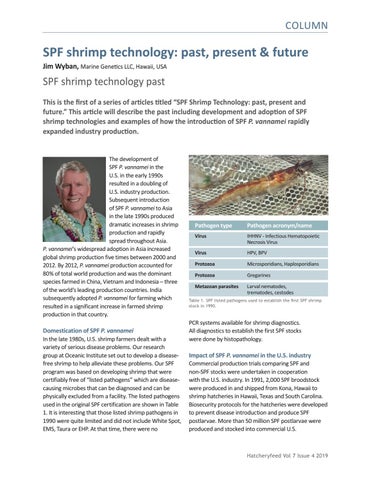COLUMN
SPF shrimp technology: past, present & future Jim Wyban, Marine Genetics LLC, Hawaii, USA
SPF shrimp technology past This is the first of a series of articles titled “SPF Shrimp Technology: past, present and future.” This article will describe the past including development and adoption of SPF shrimp technologies and examples of how the introduction of SPF P. vannamei rapidly expanded industry production. The development of SPF P. vannamei in the U.S. in the early 1990s resulted in a doubling of U.S. industry production. Subsequent introduction of SPF P. vannamei to Asia in the late 1990s produced dramatic increases in shrimp production and rapidly spread throughout Asia. P. vannamei’s widespread adoption in Asia increased global shrimp production five times between 2000 and 2012. By 2012, P. vannamei production accounted for 80% of total world production and was the dominant species farmed in China, Vietnam and Indonesia – three of the world’s leading production countries. India subsequently adopted P. vannamei for farming which resulted in a significant increase in farmed shrimp production in that country.
Domestication of SPF P. vannamei In the late 1980s, U.S. shrimp farmers dealt with a variety of serious disease problems. Our research group at Oceanic Institute set out to develop a diseasefree shrimp to help alleviate these problems. Our SPF program was based on developing shrimp that were certifiably free of “listed pathogens” which are diseasecausing microbes that can be diagnosed and can be physically excluded from a facility. The listed pathogens used in the original SPF certification are shown in Table 1. It is interesting that those listed shrimp pathogens in 1990 were quite limited and did not include White Spot, EMS, Taura or EHP. At that time, there were no
Pathogen type
Pathogen acronym/name
Virus
IHHNV - Infectious Hematopoietic Necrosis Virus
Virus
HPV, BPV
Protozoa
Microsporidians, Haplosporidians
Protozoa
Gregarines
Metazoan parasites
Larval nematodes, trematodes, cestodes
Table 1. SPF listed pathogens used to establish the first SPF shrimp stock in 1990.
PCR systems available for shrimp diagnostics. All diagnostics to establish the first SPF stocks were done by histopathology.
Impact of SPF P. vannamei in the U.S. industry Commercial production trials comparing SPF and non-SPF stocks were undertaken in cooperation with the U.S. industry. In 1991, 2,000 SPF broodstock were produced in and shipped from Kona, Hawaii to shrimp hatcheries in Hawaii, Texas and South Carolina. Biosecurity protocols for the hatcheries were developed to prevent disease introduction and produce SPF postlarvae. More than 50 million SPF postlarvae were produced and stocked into commercial U.S.
Hatcheryfeed Vol 7 Issue 4 2019
